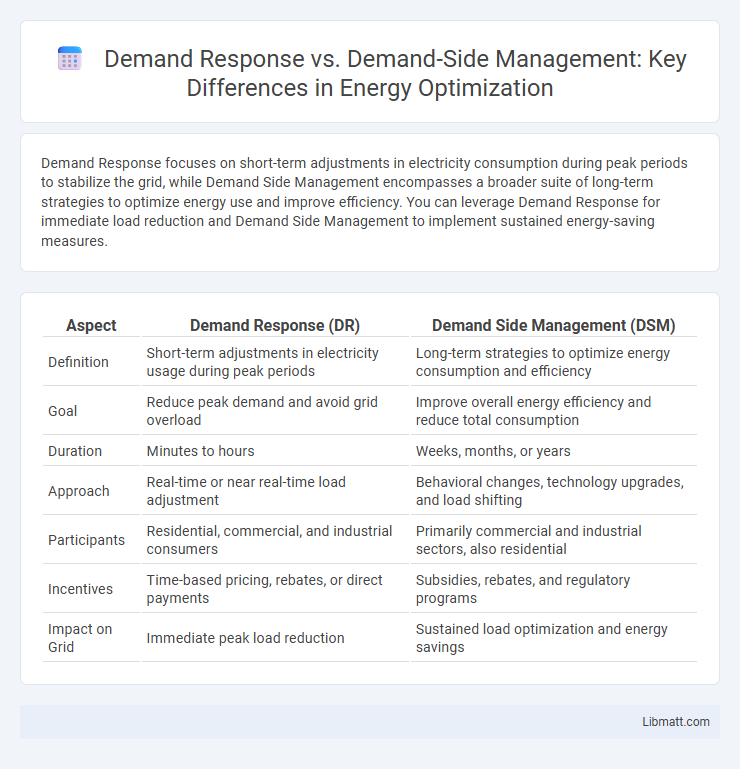Demand Response focuses on short-term adjustments in electricity consumption during peak periods to stabilize the grid, while Demand Side Management encompasses a broader suite of long-term strategies to optimize energy use and improve efficiency. You can leverage Demand Response for immediate load reduction and Demand Side Management to implement sustained energy-saving measures.
Table of Comparison
| Aspect | Demand Response (DR) | Demand Side Management (DSM) |
|---|---|---|
| Definition | Short-term adjustments in electricity usage during peak periods | Long-term strategies to optimize energy consumption and efficiency |
| Goal | Reduce peak demand and avoid grid overload | Improve overall energy efficiency and reduce total consumption |
| Duration | Minutes to hours | Weeks, months, or years |
| Approach | Real-time or near real-time load adjustment | Behavioral changes, technology upgrades, and load shifting |
| Participants | Residential, commercial, and industrial consumers | Primarily commercial and industrial sectors, also residential |
| Incentives | Time-based pricing, rebates, or direct payments | Subsidies, rebates, and regulatory programs |
| Impact on Grid | Immediate peak load reduction | Sustained load optimization and energy savings |
Understanding Demand Response: A Brief Overview
Demand Response (DR) involves real-time adjustments in electricity usage by consumers to balance supply and demand, often incentivized through dynamic pricing or load control programs. It enhances grid reliability by allowing utilities to reduce peak demand without permanently altering consumption patterns. Your participation in DR programs can lead to cost savings and improved energy efficiency through timely demand adjustments.
What Is Demand Side Management?
Demand Side Management (DSM) refers to strategies and technologies that encourage consumers to modify their electricity usage patterns to improve energy efficiency and reduce peak demand. Unlike Demand Response, which often involves short-term adjustments to consumption during peak events, DSM encompasses a broader range of long-term behavioral changes, energy conservation measures, and load shifting techniques. Your understanding of DSM can help optimize energy costs and support grid reliability by promoting sustainable consumption habits.
Key Differences Between Demand Response and Demand Side Management
Demand Response (DR) primarily focuses on short-term adjustments in electricity usage by consumers during peak demand periods to maintain grid stability and reduce costs, often triggered by price signals or incentives. Demand Side Management (DSM) encompasses a broader range of long-term strategies, including energy efficiency improvements, load shifting, and behavioral changes aimed at reducing overall energy consumption and optimizing energy use patterns. The key difference lies in DR being event-driven and temporary, while DSM targets sustained energy reduction through comprehensive planning and technological interventions.
How Demand Response Works in Modern Energy Systems
Demand Response in modern energy systems operates by incentivizing consumers to reduce or shift their electricity usage during peak demand periods, enhancing grid reliability and preventing blackouts. Advanced technologies like smart meters and automated controls enable real-time communication between utilities and your devices, facilitating rapid adjustments in energy consumption. This dynamic approach contrasts with broader Demand Side Management strategies, which encompass long-term energy efficiency programs and infrastructure improvements.
The Role of Demand Side Management in Energy Efficiency
Demand Side Management (DSM) plays a crucial role in enhancing energy efficiency by implementing strategies that optimize electricity consumption patterns and reduce peak demand. Unlike Demand Response (DR), which primarily focuses on short-term load adjustments during peak periods, DSM encompasses long-term programs including energy conservation, load shifting, and efficiency improvements. These comprehensive measures enable utilities and consumers to lower overall energy use, decrease operational costs, and mitigate environmental impacts through sustained behavior changes and technology adoption.
Benefits of Implementing Demand Response Programs
Implementing Demand Response programs significantly enhances grid reliability by balancing electricity supply and demand in real-time, preventing outages during peak periods. These programs reduce operational costs for utilities and lower your energy bills through incentives for shifting or reducing consumption during high-demand intervals. Demand Response also supports the integration of renewable energy sources, promoting a more sustainable and resilient power system.
Advantages of Demand Side Management Strategies
Demand Side Management (DSM) strategies provide enhanced grid stability by optimizing energy consumption patterns and reducing peak demand, leading to lower operational costs for utilities. DSM promotes energy efficiency through targeted behavioral changes and advanced technologies, contributing to significant reductions in greenhouse gas emissions. These strategies also empower consumers with greater control over their electricity usage, fostering a flexible and resilient energy system.
Challenges Facing Demand Response and Demand Side Management
Demand Response (DR) faces challenges such as limited consumer engagement, variability in energy usage patterns, and the need for advanced communication technologies to provide real-time data. Demand Side Management (DSM) encounters obstacles including high initial costs for implementing energy-efficient technologies, complexities in coordinating multiple stakeholders, and regulatory barriers that hinder widespread adoption. Both strategies struggle with integrating renewable energy sources and maintaining grid reliability while balancing consumer participation incentives.
Technology and Innovation in Demand Management
Demand Response leverages real-time data and smart grid technology to dynamically adjust energy consumption during peak periods, enhancing grid stability and cost efficiency. Demand Side Management encompasses broader strategies, including advanced energy storage, home automation systems, and predictive analytics to optimize long-term energy use patterns. Your energy strategy benefits from integrating innovative IoT devices and AI-driven platforms that enable proactive management and personalized demand adjustments.
Future Trends for Demand Response and Demand Side Management
Future trends in demand response highlight the integration of advanced AI and machine learning algorithms to optimize real-time grid balancing and consumer energy consumption patterns. Demand Side Management is evolving towards holistic energy ecosystems that incorporate distributed energy resources, energy storage systems, and IoT-enabled smart devices for enhanced grid resilience and efficiency. Increasing regulatory support and market incentives are driving widespread adoption of dynamic pricing models and automated demand response programs to facilitate sustainable energy usage.
Demand Response vs Demand Side Management Infographic

 libmatt.com
libmatt.com